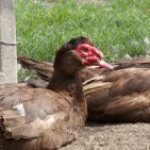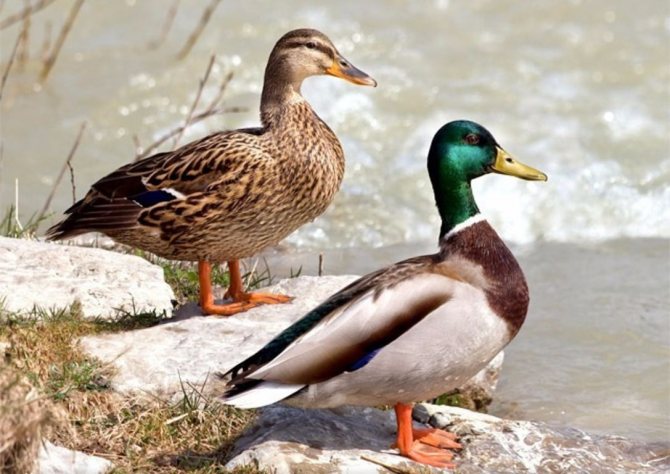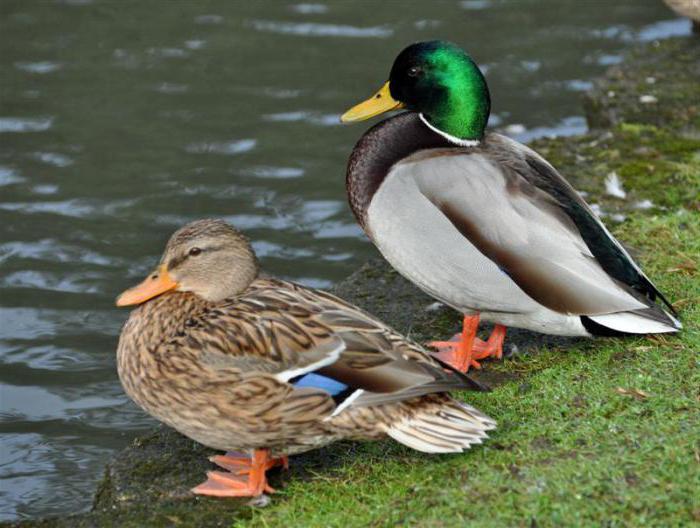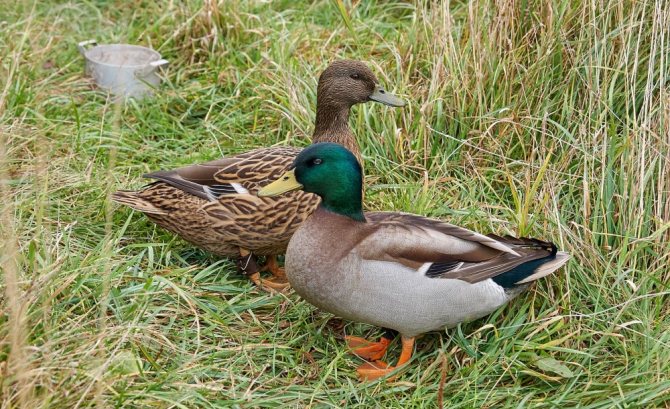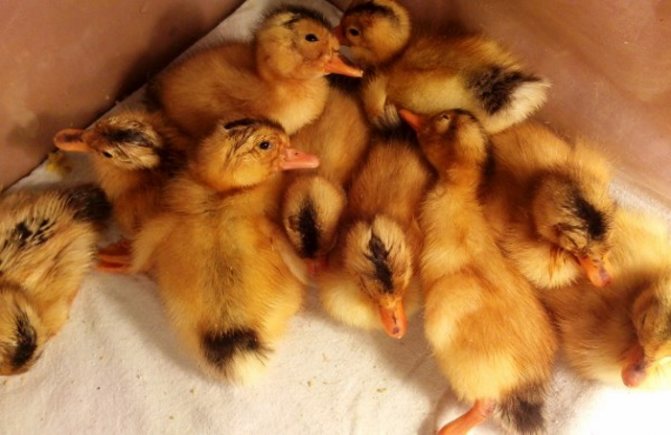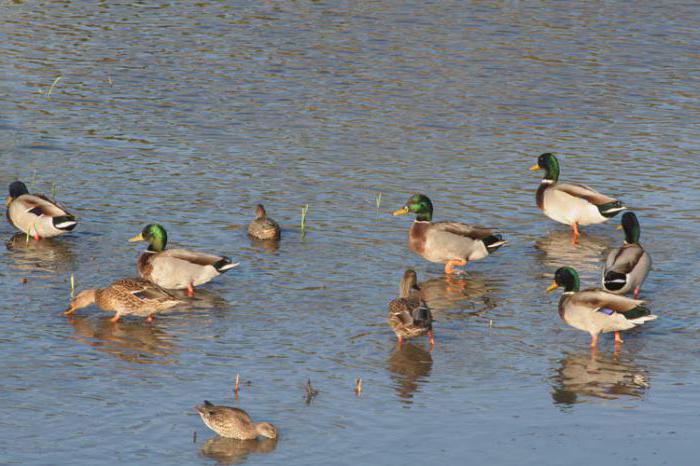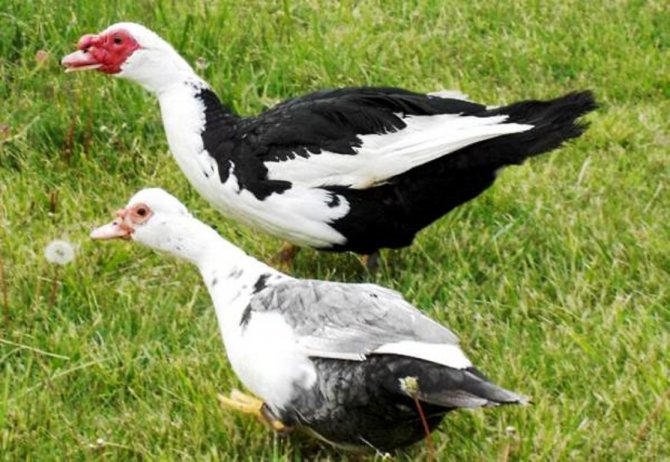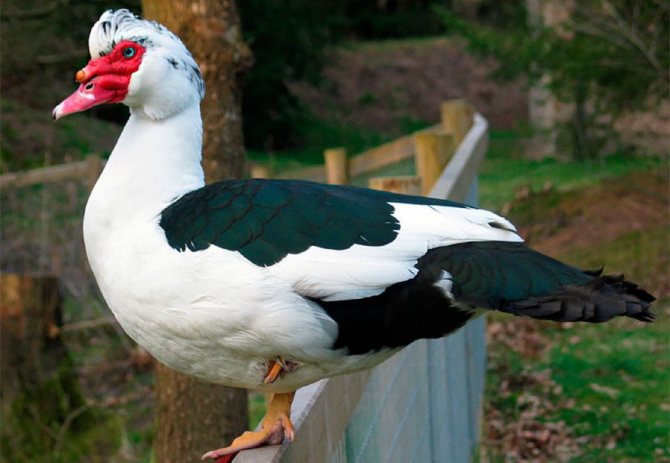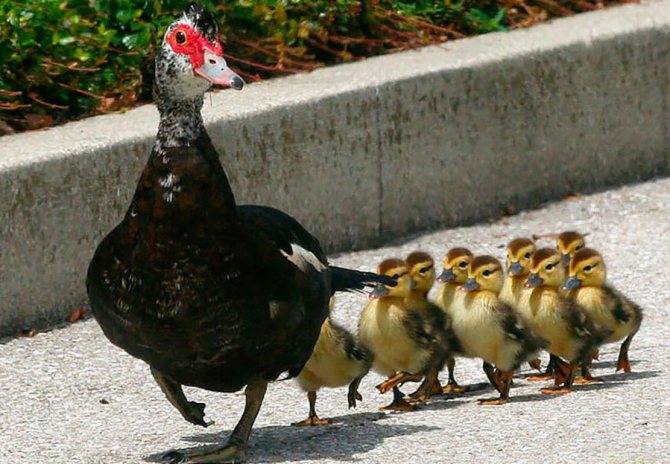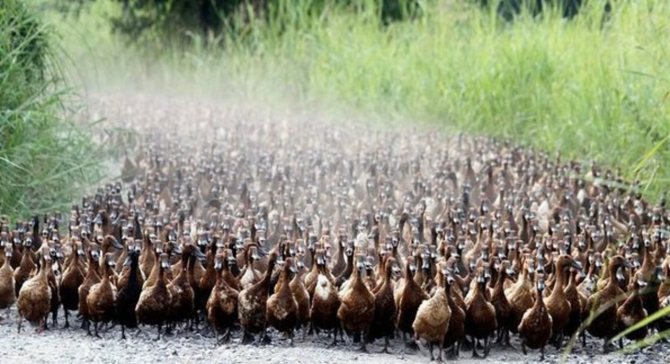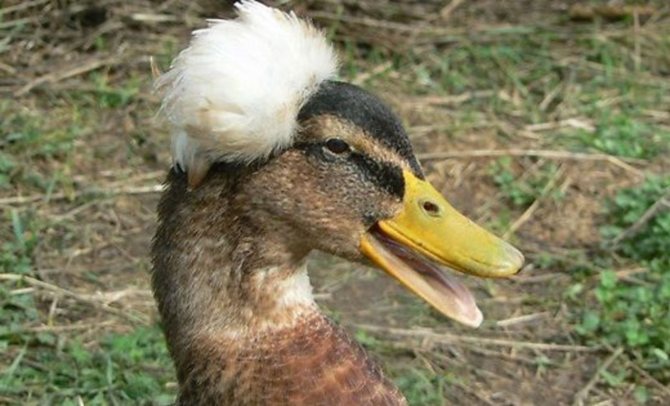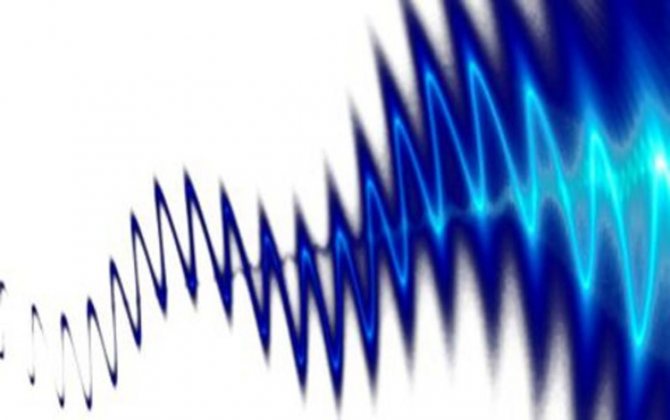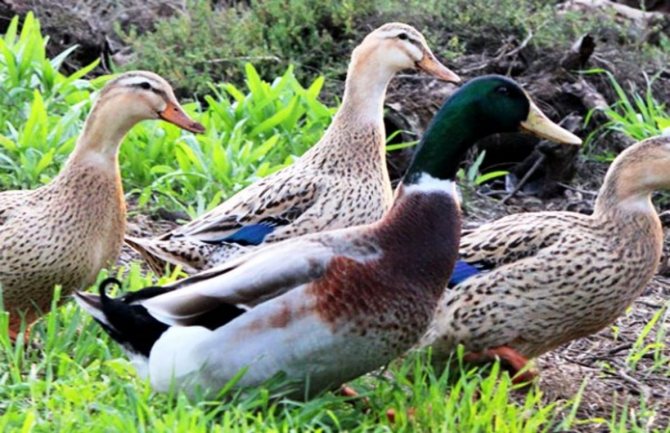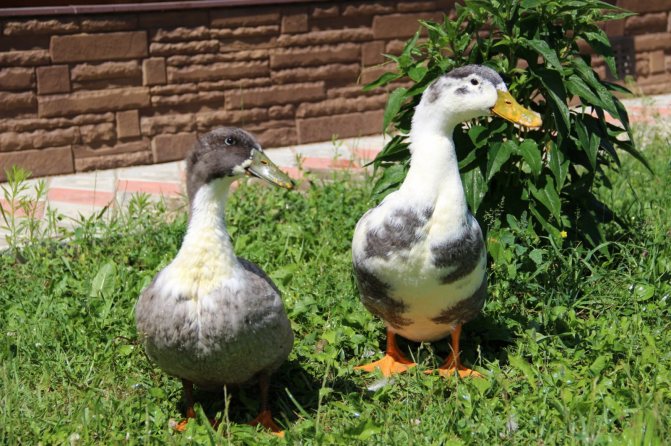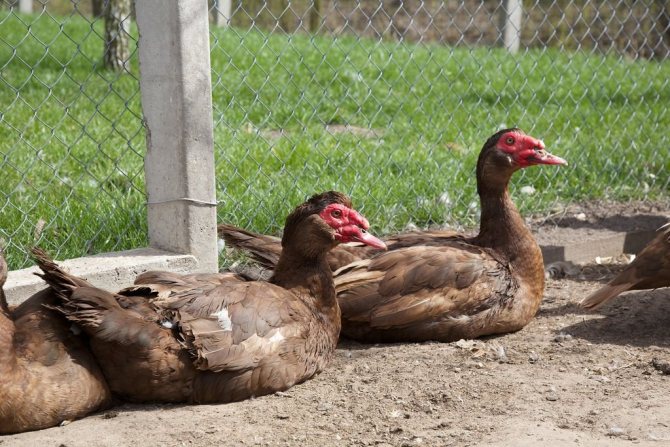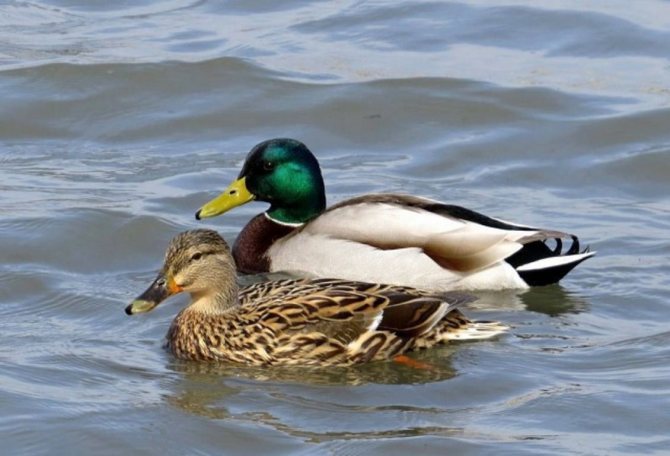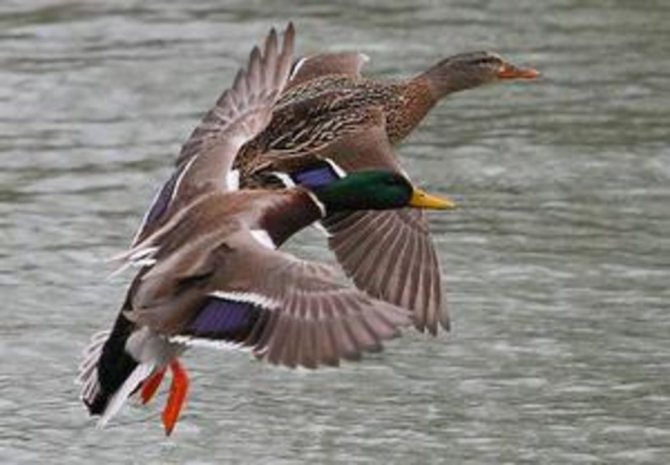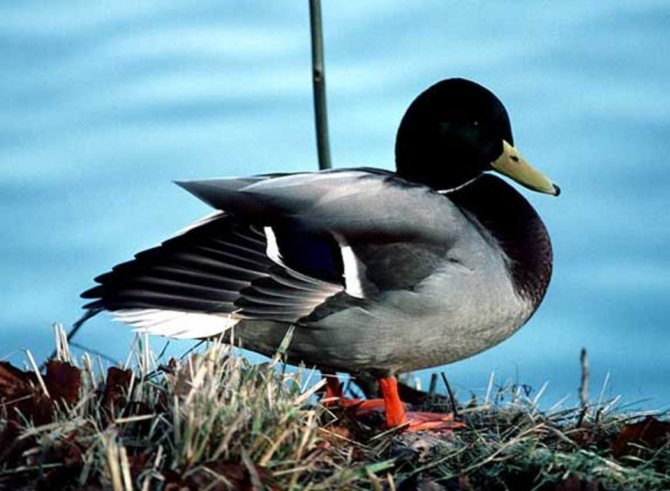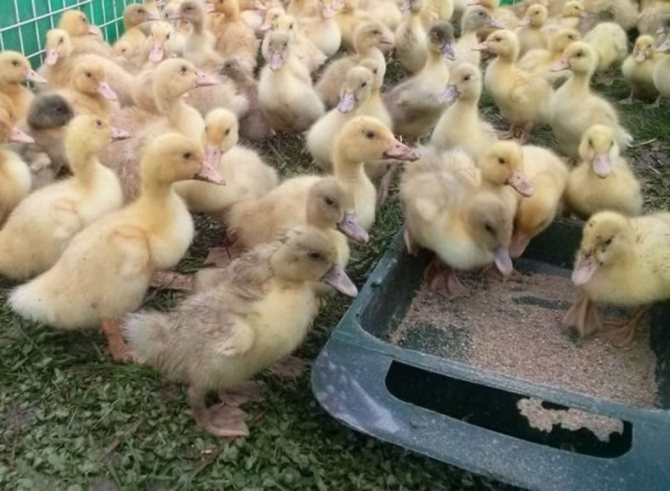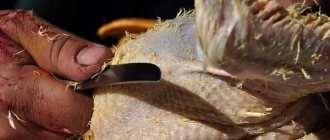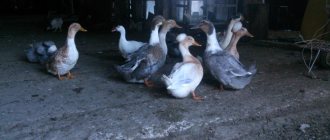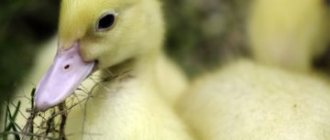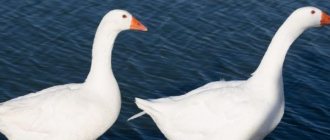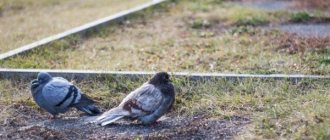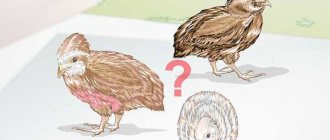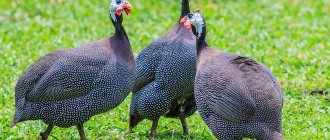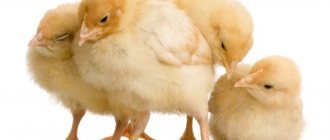How to determine the sex of a duck in the first weeks
After the ducklings have hatched, they are examined, sick babies are removed and the future flock is divided according to gender. This will enable farmers to assess the economic performance of their livestock.
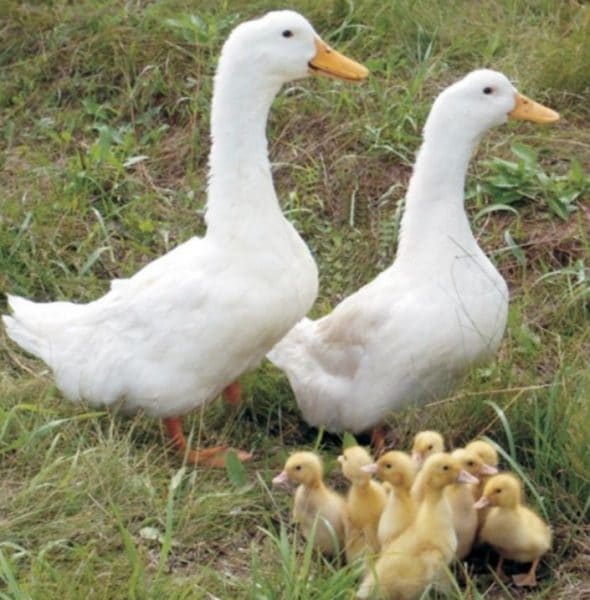
Distinguishing the sex of poultry is not difficult
A number of signs that will help distinguish a small drake from a duck:
- The structure of the larynx. In boys, unlike girls, it is wider and shifted to the left. A blister-like formation up to 6 mm in size is felt to the touch. Ducks don't have that. This method is used as follows. The duckling is taken in hand and its head is turned to the left side, the beak is raised up. In the drake, a tubercle is felt in the solar plexus area, the female does not.
- Down color. Young drakes are distinguished by colorful plumage. Often, small ducklings have a blue or green spot on the wing, in everyday life it is called a "mirror".
- Head diameter. A small male duckling has a head size several centimeters larger than that of a duck. Outwardly, it is easy to determine when the entire brood is in the same room.
- Neck structure. In females, the neck is thin and shorter in size.
The methods will help to determine the sex of the young livestock with an accuracy of 80%.
Japanese method of sex determination in poultry
Experienced poultry farmers claim that this method will help determine the sex of a bird with an accuracy of 95%.
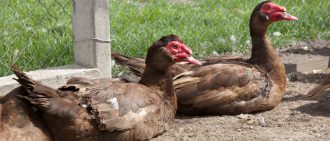

Be sure to read:
How many eggs does an Indo-duck lay and how many days ducklings hatch, how to lay eggs
The procedure is carried out when the ducklings are 1-2 days old, they dry out and their umbilical cord will fall off.
Actions are carried out carefully, manipulation is dangerous for little ducklings.
Procedure order:
- The chick is gently placed on the hand, back to palm, gently massaged the abdomen.
- The plumage is spread with a finger in the area of the cloaca and easily pressed in the area of the anal canal.
- Males will show a small spiral 2-2.5 mm in size. The little duck has small spherical protrusions.


Japanese method of sex determination in poultry
There is a popular method for determining sex. The duckling is carefully taken by the paws and gently lowered with its head down. The female is in this position without moving.
The young drake, on the contrary, will turn around, examine the environment, try to get out.
Folk way
There are proven and quite simple ways to distinguish ducks from drakes, which were used by our ancestors and modern farmers.
- In males, the lower larynx has an expanded shape. To check, you need to feel the chest of the chick. Take your head to the side, raise the beak so that the neck is straight. Attach the thumb of the left hand to the upper vertebrae, and with the index fingers, find and enter the triangle in the brisket. A tubercle should be formed in it - a hard sac connected to the bones of the chest, scapula and clavicle. This feature is only present in males.
- The people say that male ducklings love to get involved in fights and conflicts. And it doesn't matter for what reason. The reason may be as a desire to dominate around the trough, the same manifestation of signs of attention in relation to the "fair" sex at the age of 1 month and older. Have noticed that there are such in the herd - be sure, males are in front of you.
External differences between drakes and ducks
It is important to be able to distinguish a drake from a duck, this will help to choose the right number of livestock in the general flock. There are 5-6 females per male. The correct ratio will help to achieve a higher egg production.
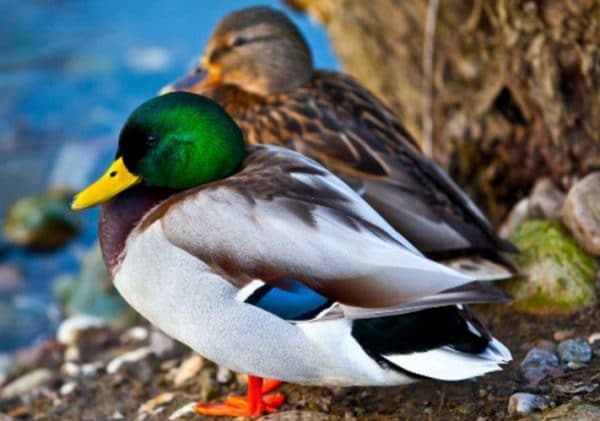

The structure of the larynx. In boys, unlike girls, it is wider and shifted to the left.
A drake from a female is easy to identify by external signs:
- Feather color. Males are distinguished by bright plumage. The head and tail of some species are green. In females, the body and head are colored in the same tone.
- Body size. Grown young growth is easy to distinguish from each other. Males are larger in size, the mass is much larger.
- Head size and forehead shape. The female has a smaller head, without a growth on the forehead.
- The presence of a tuft. Only a drake can see a crest on his neck.
- Beak size. The female has a smaller beak.
Character differences
Ducks are easily distinguished by their behavior, but for this it is worth observing the flock for a long time.
Males walk at the end of the pack. They have a restless nature, they constantly fight for dominant positions with other drakes, try to get out of the fenced area, fly over the fence.
Females do not participate in fights, their wings are less often clipped, they lead a calm and quiet lifestyle. Poultry farmers indicate this behavior only when the ratio of individuals in the flock is correctly selected.
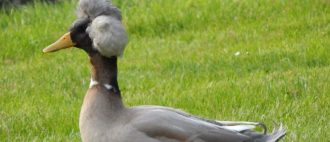

Be sure to read:
Common diseases of ducks: why do ducklings roll over on their backs and jerk their paws?
If the balance of ducks and drakes in the population is disturbed, the birds behave differently. Females come into conflict with other ducks, and the male hides in a corner, fearing the attack of other individuals.
Feeding
These birds are almost omnivorous. Wet food is best eaten. You can finely chop herbs, beet tops, grain and kitchen waste. These birds eat corn kernels well. The barley must be soaked beforehand. These birds consume relatively less food than ducks of other breeds. With a reservoir, the hassle of feeding ducks is reduced several times, since the birds are able to get some part of their food themselves. Various insects, worms and other small creatures will certainly benefit the bird.
Leghorn chickens: characteristics and economic benefits of breeding
The danger is that muscovy ducks often show interest in shards of glass, metal, nails and other things that can harm the health and life of the bird. This means that care should be taken to keep the duckhouse and yard clean. You can not feed the birds too warm food, but too cold too, regardless of weather conditions. If there are several species of birds in the poultry yard at once, then you should not feed them at the same time, as the birds can fight.
In winter, it is impermissible to let the duck go to the reservoir in search of food.
Sexual characteristics of duck and drake
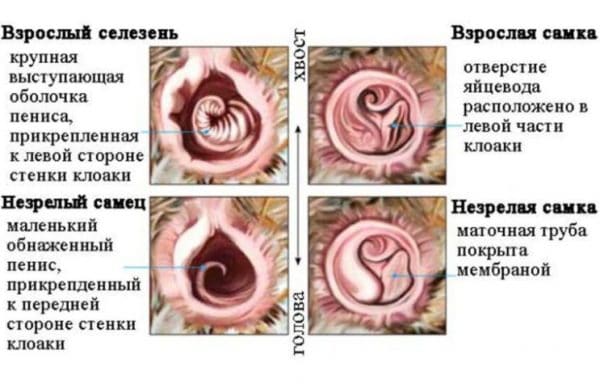

External sexual characteristics of ducklings
How to determine the sex of an older domestic duck:
- The bird is turned over on its back, the wings are firmly held by the hand.
- Feathers are separated by hands in the area of the cloaca.
- If it is a duck, the breeder will notice two round growths in the lower abdomen. The drake has a rudimentary penis, commonly called "pseudopenis".
For inexperienced breeders, it is difficult for the first time to learn how to separate birds by sex, especially if they are young chicks. For experienced farmers, determining the sex of a domestic duck is easy.
Little ducklings are given small marks according to the sex and released into the flock. This will avoid re-checking the birds and will make it easier to count the number of drakes and ducks in the total flock.
Care
These birds are not very fond of the heat, so if ducks are born in a warm season, then portable bird sheds should be used.
In the cold period, warm conditions should be created in the poultry house, since initially this species of ducks lived in a warm climate, due to which fat did not accumulate under the skin, and to this day the ducks are freezing.
In winter, a solid, strong, capital poultry house is needed, which will allow the birds to hide from the sudden appearance of cold. The interior should be light and dry, and other animals and birds should not be allowed to enter the house. It should only belong to these birds.
Birds need to be walked. Not in the sense that it applies to dogs and sometimes to cats, but still necessary. You need a medium-sized courtyard in which the Indo-girls will spend enough time. The courtyard must be fenced off with a fence or mesh.
Breeding pigeons at home
If it is not possible to organize a proper poultry house, then musk ducks can be kept in cages.
If possible, the house should be divided into parts. One of them should be covered with a net with two-millimeter rods at a height of 25 centimeters. In addition, good, permanent bedding should be provided.
There should be items in the house to keep the birds comfortable. These items include:
- Feeders. Wooden or metal. Dry food goes well with wood, and wet food goes well with metal.
- Drinking bowls. They must have a large volume and a free approach to them at any time. Indo-women need a lot of water.
- Nests. The nests should be arranged on the floor, lined with fresh straw. Straw must be replaced in a timely manner. You can make a nest in the form of a house with an entrance 10 centimeters above the floor.
The temperature inside the house should be around 18–20 degrees Celsius, however, it should not fall below 15, as the ducks will begin to freeze, which can lead to disease.
The difference in the male voice
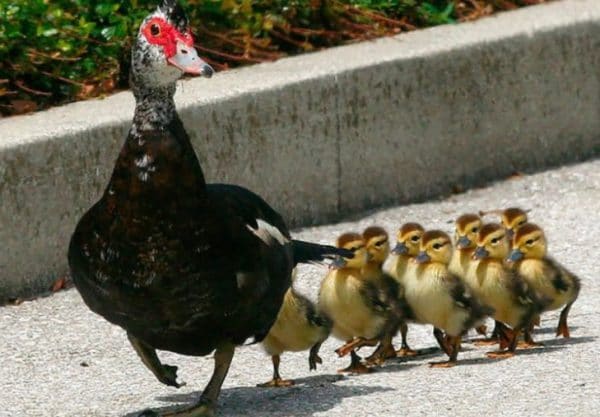

External differences between Indo-girls begin to form only after reaching 3 months
It is easy for a novice breeder to distinguish poultry by the sound it makes.
This could be:
- gaggle;
- hiss;
- light whistle;
- trill;
- trumpet cry.
The drakes, due to the structural features of the trachea, emit only hiss. Ducks are more talkative. The drakes are silent, after a hiss, a faint whistle is sometimes heard.
Differences between ducks and drakes of different breeds
Males and females of each breed have characteristics that make them easy to distinguish from each other.
Characteristics of subspecies:
- Muscovy duck (Indo-duck). Drake is distinguished by its appearance. On the head above the beak there is a burgundy or red "outgrowth". There are spots of the same color near the eyes. The ducks also have slight "growths", but they are light in color, as well as small spots near the eyes. The male is larger than the female.
- Peking breed. The appearance of the birds is similar, they have light plumage. Representatives of the breed are distinguished by their tail. In the drakes, it is twisted into a small ring.
- Favorite. The male has a larger head, an elongated neck, and larger paws. The weight of the drake is 5 kg, the duck is 3.5 kg.
- Wild ducks. Sex is easily identified by the bird's appearance. The drake has bright plumage, the color of the feathers on the head and tail differs from the color of the body. Wild ducks have a discreet, monochromatic dark brown color.
Important! If the poultry farmer does not control the ratio of males to females in the livestock, it is difficult to determine whether ducks will become. Ducks behave like drakes and vice versa.
Large duck family
Ducklings are the largest family of birds with the ability to swim, with approximately 150 species of birds. Many of them, the mallard, for example, have been successfully domesticated for a long time and are kept for obtaining eggs, tender fluff and delicious meat. There are more than 110 species of ducks in the world, 30 of which are common in Russia.
Typical representatives of duck
Ducks are found mostly of medium size with small heads and necks. The color of birds comes in a variety of shades. Some species are characterized by sexual dimorphism clearly manifested during the mating season, visible to the naked eye by differences in the color range of plumage.
Mature mallards are characterized by pronounced sexual dimorphism
Domestic ducks that have taken root on farmland are descended from the mallard. Some of the most popular beef breeds in Russia are Peking, Mulard, Bashkir, Musk, Moskovskaya Belaya, Favorite Goluboy, and Chernaya Belogrudaya. The leaders of the mixed direction are Khaki Campbell, Cayuga and Saxon, and among the excellent layers, the Indian Runners have proven themselves well.
Indian Runners
Black White Chest
Some species of ducks can be easily divided into male and female individuals, based only on the features of the exterior. Cayuga, Mulard, Bashkir, Musk, Saxon and many other species are quite easy to differentiate, although they cannot do without nuances.
The color of the male mallard after molting acquires "female" features

